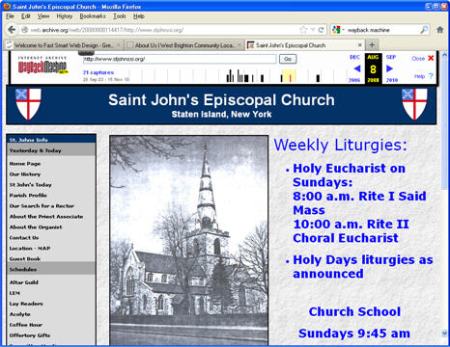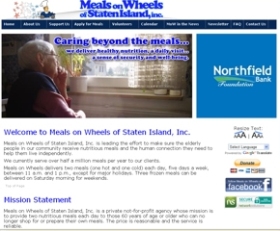A few years ago, St. John’s Episcopal Church on Staten Island hired us to revamp their website. The original site was serviceable but, well, blue-ish and gray-ish, and not very welcoming. Here’s a screenshot, captured from the Wayback Machine:
Why Maintaining Your Own Site Works
September 3, 2012How Unitarians Do a Website
December 26, 2011Churches and other faith-based organizations often have wonderful websites, right up until the people who created them leave. Sometimes they move away; sometimes they burn out. In either case, the organization is left with a site that becomes more outdated every week, once a week.
The Unitarian Church of Staten Island was almost in this position. Their longtime webmaster was stepping down, but luckily, two members of the Communications Committee were willing to take on the job.
But let me digress for a moment: The Unitarian Church of Staten Island, which was founded by abolitionists, has a long history of social activism. Their most famous member was Robert Gould Shaw, who led the 54th Massachusetts Regiment composed of freed slaves, in the fateful Civil War attack on Battery Wagner, Morris Island, SC. He was immortalized, along with his regiment, in the film Glory.
The 21st century members are no slouches either. Their Social Justice Committee is involved with the Staten Island Building Bridges Coalition and helped celebrate Food Day 2011. One of their Small Group Ministries has a fair trade coffee program, and the church itself shelters homeless men from Project Hospitality every night.
So it was obvious to us at Fast Smart Web Design that this group of people would have the intellectual, physical, and spiritual energy to maintain their own site. We showed one member how to use Adobe Contribute, and the other already knew how to use Adobe Dreamweaver. Between them, they’ve kept the site up to date and have solved most of the inevitable glitches on their own. Check out their Sunday Services and Upcoming Events pages to see how well they (as well as the church) are doing.
The web administrators said they’re willing to talk to other faith-based organizations about the process of redesigning and then maintaining an organizational website. Not all the issues are technical, they point out — the team needs to be able to manage privacy, workload, and interpersonal issues as well. Contact us if you’d like to get in touch with them.
Designing Art in the Afternoon (fish in the morning)
December 26, 2011Fast Smart Web Design has worked with Naima Rauam on her site, Art in the Afternoon (fish in the morning), through two design iterations. Both the first and current versions are notable for what’s not there: No colored backgrounds, no busy banner, no complicated navigational strategies. Instead, because the site is so simple, your eye is drawn to the paintings themselves.
Why is the site called “Art in the Morning (fish in the afternoon)”? Simple: When Naima started painting at the Fulton Fish Market, one of the fish mongers let her set up a gallery in his shop after the market closed at 11 a.m.
With Art in the Afternoon, we learned two things:
- The more descriptions you include, the better search results you get. This is obvious, of course, but it’s time-consuming to write descriptions–and if you’re spending your time describing old pieces, when do you get time to make new ones? But as Naima adds more text, her Google Analytics page shows more hits.
- Simplicity is not for everyone. When we showed Naima’s site to Russians in our usability workshop in Moscow, they didn’t like it at all. But after we toured the Hermitage in St. Petersburg a few days later, we guessed why the minimalist style was so unpopular in Russia. If your ideal staircase looks like this, why would you like a plain white background?
What We Did for Meals on Wheels of Staten Island
December 26, 2011As a Meals on Wheels (MOW) volunteer since 2001, Victor has been delivering meals every Wednesday to about twenty elderly clients. He noticed that the Meals on Wheels of Staten Island website hadn’t been updated for years, and when he asked, he found that MOW didn’t have much of a relationship with their web developers. They had trouble contacting anyone at the company and no one from the company tried to contact them.
Fast Smart Web Design offered to redo the website and set up the new version in such a way that the (extremely overworked) volunteer administrator could easily update the pages herself. She now regularly updates the newsletters and tweaks the pages when rules or procedures change.
In the redesign, we also
- connected Meals on Wheels with PayPal for donations, memberships, and events
- created volunteer and client application forms with reCAPTCHAs to reduce spam
- added an SSL certificate to make sure that no one outside MOW could access clients’ information without their permission
- added a translation widget to make it easier for multilingual clients to understand what was on the pages
- included a widget that made the type larger (or smaller) to help older adults read the pages
Rejected! Tattfoo Tan on getting rejection letters
December 9, 2011COAHSI’s blog has a write-up by Tattfoo Tan on applying for arts grants, what it feels like to be rejected, and what to do about it. Perfect. Check it out.
The 1776 Celebration at the Conference House
September 7, 2011The following describes the 2010 1776 Peace Conference Celebration at the Conference House on Staten Island. It is by Nicholas Zvegintzov, whose many interests and projects are visible here: http://www.maint.com/.
I successfully but sleepily caught the 11:01 train in St. George, about 45 minutes to Tottenville, the end of the line, where the front of the train almost ends in the water at a long-abandoned ferry landing.
I first took this trip in 1979, when there were still some old wooden rail coaches on a siding and on the street approaching the ferry a boarded-up porticoed building, perhaps part of an old hotel. Both are gone, but otherwise it is very much the same – well, more clustered town houses on the far side of the Kill van Kull.
I walked through prosperous tree-lined streets past some pleasant houses built on the shore, and got directions from a man who was exercising two dogs and two teenage daughters. He comes here every Sunday, but had little idea what the Conference House was or the Conference. ‘In 1976? Ah, 1776. Tell my daughter, she should learn.’ His daughter of course not very interested. Read the rest of this entry »
Secede from the Union over Farm Food? Maine Town Passes Landmark Local Food Ordinance
April 25, 2011In March, Sedgwick, a small town on the coast of Maine, passed a “Local Food and Self-Governance Ordinance” that says that farmers selling directly from their farms to customers don’t need to be licensed or inspected by state and federal governments. The ordinance also exempts foods made in home kitchens from licensing and inspection.
Sedgwick farmer Bob St. George points out that “until the last couple generations, we didn’t need a special license or new facility each time we wanted to sell something to our neighbors. Small farmers and producers have been getting squeezed out in the name of food safety, yet it’s the industrial food that is causing food borne illness, not us.”
The ordinance is online (http://savingseeds.files.wordpress.com/2011/03/localfoodlocalrules-ordinance-template.pdf) to make it easy for other towns to follow Sedgwick’s example. However, one of the ordinance’s most interesting aspects is the declaration of (possible) independence:
The foundation for making and adoption of this law is the peoples’ fundamental and inalienable right to govern themselves, and thereby secure their rights to life, liberty, and the pursuit of happiness. Any attempt to use other units and levels of government to preempt, amend, alter or overturn this Ordinance or parts of this Ordinance shall require the Town to hold public meetings that explore the adoption of other measures that expand local control and the ability of citizens to protect their fundamental and inalienable right to self-government. It is declared that those other measures may legitimately include the partial or complete separation of the Town from the other units and levels of government that attempt to preempt, amend, alter, or overturn this Ordinance.
Is selling food at a farm stand an inalienable right? It made me laugh at first, but here on Staten Island, it seems that neighbors aren’t allowed to sell, swap, or even give away their backyard produce except under of cover of night, over the back fence. That can’t be right. Bushels of figs, apples, and persimmons rot on the ground every fall while folks in the housing projects can’t afford an old peach in the local bodega.







